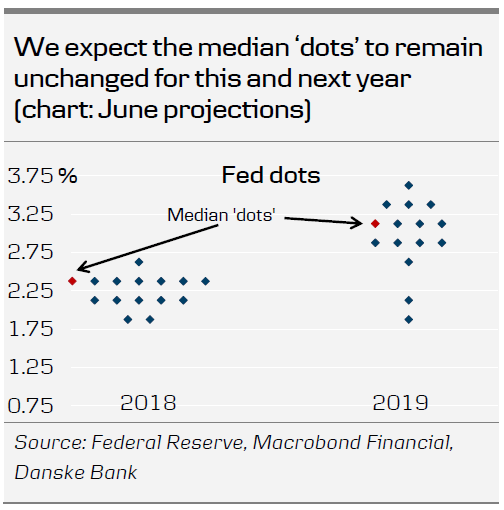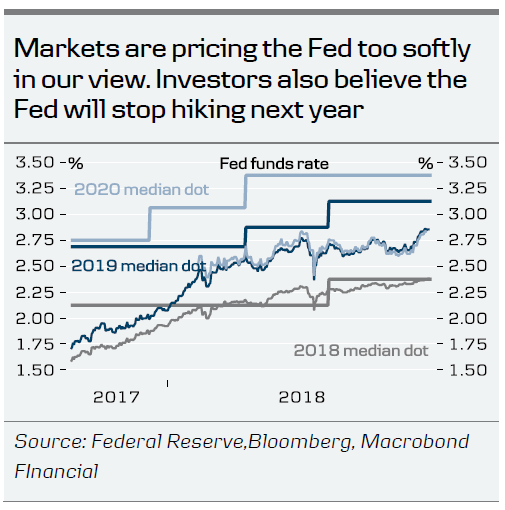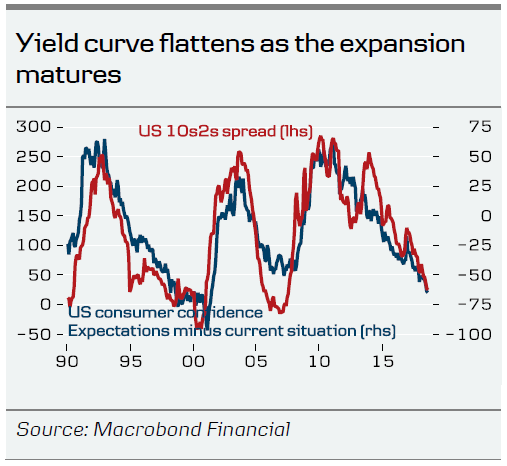- As the real economy is in good shape, the Fed is on autopilot until the target range reaches 2.75-3.00% (most FOMC members’ estimate of the neutral rate)
- After neutral is reached, it is more ‘stop and go’ depending on how the economy is doing and how markets are reacting to the monetary tightening. We expect the Fed to continue hiking next year.
- We continue to see modest upward pressure for 10Y US treasury yields and have a 12M forecast at 3.25%.
- Continued Fed hikes should help EUR/USD revisit the 1.15 area again during the course of the autumn.
Fed outlook: Fed on autopilot at least until March
In line with everyone else, we expect the Fed to raise the target range by 25bp to 2.00- 2.25% at next week’s meeting. We do not expect it to be necessary for the Fed to send any new important signals to the markets. We believe the most important parts of the statement will remain unchanged and even if the sentence ‘monetary policy is accommodative‘ is removed or changed, it should not matter much, in our view, as it would just reflect reality.
With respect to the dots, the Fed will most likely still signal another hike in December (and probably that more FOMC members support this) and three hikes next year (it was divided between two or three additional hikes next year and it would take four members to move it higher). The Fed will also still signal that it is going to raise the Fed funds rate above the longer-run dot. The longer-run dot may be revised higher to 3.00%.
Currently, most FOMC members are signalling that the (nominal) natural rate of interest (the rate where monetary policy is neither expansionary nor contractionary) is around 2.75- 3.00% and many, even the more dovish members, have signalled in speeches that the Fed is on autopilot until neutral is reached. That means that the hikes in December and in March seem very likely. Another hike during the summer next year, perhaps June, is also likely. The real economy is in good shape and is stronger than when the Fed started its tightening cycle: Growth is strong, employment continues to rise, wage growth is increasing, PCE core inflation is 2% and optimism is high. The trade war has not had a material impact on the US economy so far, partly because the US economy is quite closed and partly because the massive fiscal boost is offsetting the negative impact from trade.
After the Fed funds rate reaches neutral, it is more ‘stop and go’ depending on how the economy is doing and how markets are reacting to monetary tightening. At the June meeting, Fed Chair Powell hinted that the reason why the Fed removed much of its forward guidance was because he wants more flexibility going forward. It is also going to be easier, as every meeting is ‘live’ next year when Powell is hosting a press conference after every meeting. We believe the Fed will be able to continue hiking with one hike in H2 19 (i.e. three hikes next year and a total of five hikes from now until year-end 2019). Markets are pricing in 3.75 hikes from now until year-end 2019 (i.e. including the hike next week).
Recently, Brainard held a very interesting speech, where she discussed the concept of the natural rate of interest. She argues that there are short-term fluctuations in the natural rate of interest, meaning that you should distinguish between the short-run and long-run natural rate. While the Fed’s median longer-run dot (2.875% currently) is an estimation of long-run natural rate, she believes the short-run rate is higher. In other words, Brainard believes it is necessary for the Fed to raise the Fed funds rate above 2.875% to keep monetary policy neutral. So, in line with our base case, the Fed will not necessarily stop hiking in mid-2019 and may continue into 2020.
The flattening of the US yield curve has attracted a lot of attention recently, not just by investors and Fed watchers but also by the Fed itself, as a negative US 10s2s spread has historically been a reliable indicator of a forthcoming recession. The minutes from the last meeting suggest that it is something the Fed is monitoring. Still, we would like to highlight two things: (1) the 10s2s spread is still positive and needs to turn negative and stay there for a while before it is a reliable recession signal and (2) more narrow spreads like the 2s3m need to turn negative as well. That said, there is an internal division between the Board of Governors, who do not seem so concerned right now, and the Regional Presidents, who seem more concerned. We believe the Fed will react accordingly if markets send a strong recession signal but we are not there yet.
Fixed Income: little impact on US treasuries
US Treasury yields have moved higher over the past couple of weeks and we have finally decisively broken the technical important 3% level in 10Y treasury yields. Given that we are not looking for any news from the FOMC this time, we see little market impact.
We continue to see modest upward pressure for 10Y US treasury yields and have a 12M forecast at 3.25%. For more, see the latest issue of Yield Outlook, 17 September.
FX: still pockets of USD strength left
With the Fed set to stay on autopilot for now, US rates are set to stay a source of USD support. This should help cement the status of the dollar as a carry currency both in terms of the level of and the change in short-end yields. With the Fed still keen to continue the process of moving rates back towards ‘neutral’, it remains too early in our view for the FX market to price the Fed going on hold. This should help EUR/USD revisit the 1.15 area again during the course of the autumn. But, as the ECB is set to signal a first hike coming up at a time where the Fed could be looking to go on hold, a EUR/USD uptick will start to materialise. Indeed, it is when easing stops – rather than when hikes occur – that currency appreciation is seen, and vice versa.



















